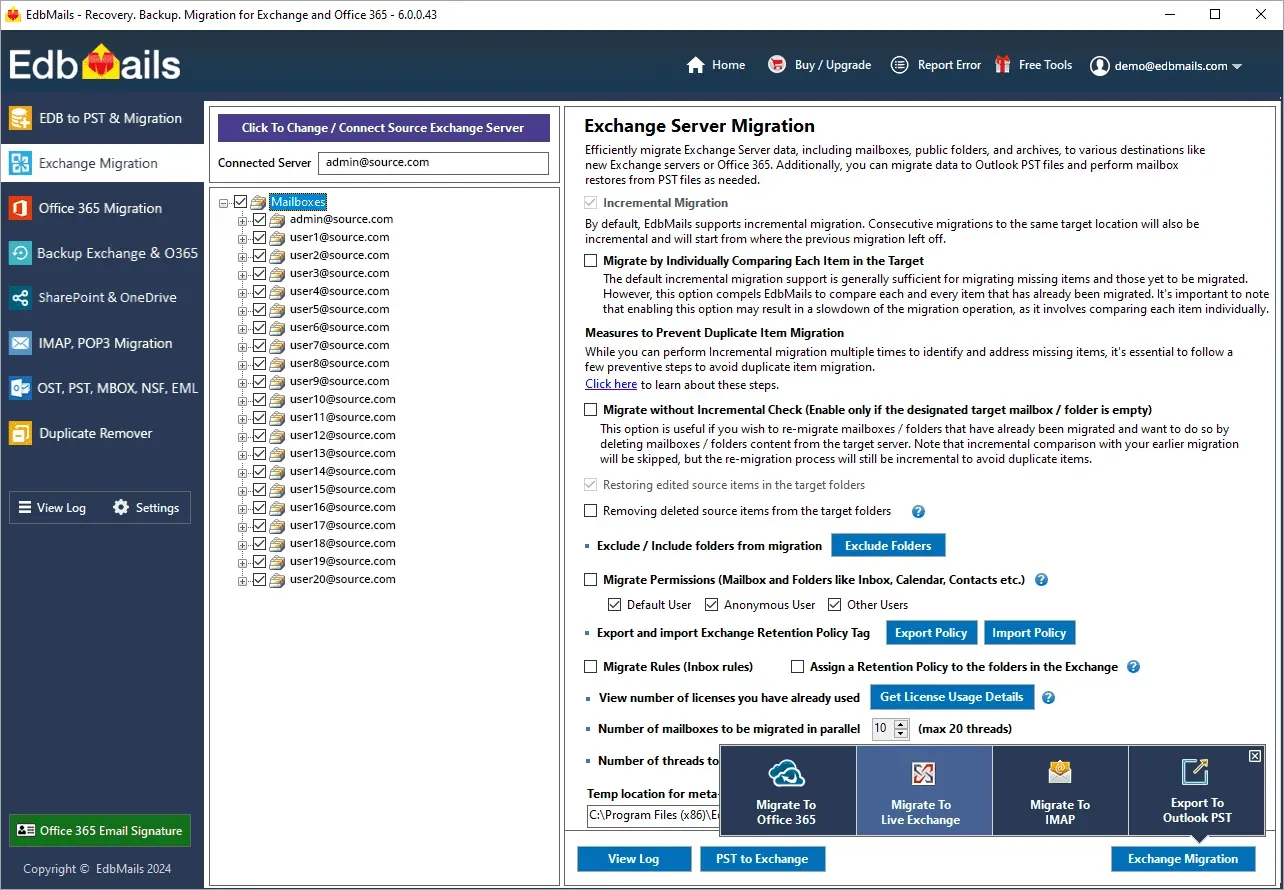One-hop migration: Revolutionizing Exchange migration
Many organizations still rely on legacy Exchange servers like 2007 and 2010, facing complex hurdles when migrating to modern environments. Native tools often fall short, lacking the ability to ensure seamless coexistence and efficient data transfer. EdbMails solves this problem by offering a direct, one-step migration to the latest Exchange versions, preserving data integrity and ensuring a smooth transition with minimal disruptions.

Challenges of legacy to latest Exchange migration
Migrating directly from legacy Exchange versions like 2007 to 2013, 2007 to 2016, or 2010 to 2019 using native tools is difficult because these versions cannot coexist within the same Active Directory environment. This requires a two-step migration process:
Stage 1 : Data is migrated from the legacy Exchange server, such as Exchange 2007 or 2010, to an intermediate environment like Exchange 2013 or 2016, which supports coexistence with the target Exchange version. Once this initial migration is complete, the legacy Exchange server, such as 2007 or 2010, can be decommissioned.
Stage 2 : The data is then migrated from the intermediate Exchange server, such as Exchange 2013 or 2016, to the final destination server, such as Exchange 2016 or 2019. After this transfer, the intermediate Exchange server can be decommissioned.
Single hop migration
A single-hop Exchange migration is crucial for simplifying and streamlining the process of moving from legacy Exchange servers to modern versions. Unlike multi-stage migrations, which involve multiple transfers and increase the risk of data loss, downtime, and complexity, a single-hop migration allows for a direct transfer in one seamless step. This approach minimizes disruptions, reduces the overall migration time, and ensures data integrity. Additionally, it eliminates the need for temporary intermediate servers, making the process more cost-effective and less resource-intensive, while providing a smoother transition to the latest Exchange environment.
Single hop Exchange migration with EdbMails
EdbMails Exchange migration software supports one-hop migration, simplifying the process of migrating data directly between any two Exchange servers. Whether migrating from Exchange 2007 to 2013, from 2007 to 2016, or from 2010 to 2019, EdbMails enables direct migration without requiring a two-step process. The software ensures zero downtime, allowing uninterrupted service throughout the migration.
With EdbMails, organizations can perform cross-forest migration directly from Exchange 2007 and 2010 to newer versions like Exchange 2013, 2016, or 2019. EdbMails is designed for ease of use, ensuring a hassle-free migration of your organization’s data between different Exchange environments, making it an invaluable asset for those looking to modernize their systems.
How to perform single hop migration using EdbMails ?
EdbMails simplifies single hop migration between Exchange servers, regardless of the versions involved. The software allows for single hop migration without any intermediate steps, enabling a smooth transition from Exchange 2010 or 2013 to Exchange server 2016 or 2019. EdbMails is the ideal choice for migrating your Exchange server data.
Steps to migrate directly from Exchange 2010 to 2019 using EdbMails
Benefits of single hop migration
- Reduced Downtime : Utilizing EdbMails for single-hop migration significantly minimizes system downtime by enabling a direct transfer of Exchange mailbox data. This approach ensures that users experience no disruption, maintaining service availability throughout the migration process.
- Simplicity and Speed : The single-hop migration method simplifies the process by reducing the number of steps involved, streamlining the entire migration journey. This efficiency not only leads to faster migration times but also allows organizations to quickly harness the benefits of their new environment with EdbMails.
- Cost Efficiency : By simplifying the migration process and eliminating intermediate steps, EdbMails helps organizations reduce operational costs. This cost efficiency minimizes the need for extensive resources and can significantly lower expenditures related to downtime and support during the migration.
Best practices for successful Single hop migration
- Thorough assessment : Identify all components to be migrated and evaluate their interdependencies. Assess potential compatibility issues with the target environment to prevent migration failures.
- Network planning : Ensure the network infrastructure can support the migration process. This includes evaluating bandwidth requirements and ensuring that the network is secure, reliable, and capable of handling the data transfer without significant bottlenecks.
- Pre-migration testing : Test in a staging environment identical to the production setup. This helps identify potential issues before the actual migration, allowing for adjustments to be made in advance.
Additional resources:
- Migrating older version of Exchange server to Exchange server 2016
- Step by Step guide for Exchange 2010 to 2016 Migration
- User Manual for Exchange Server Migration
- Videos - Exchange to Exchange Migration
- Step by step guide for Exchange 2010 to 2019 migration
- Complete guide for Exchange 2013 to Exchange 2019 migration
- Comprehensive guide for Exchange 2013 to 2016 migration
- Step by step guide for Exchange 2016 to Exchange 2019
- Complete guide for Exchange 2007 to Exchange 2016, 2019 migration


